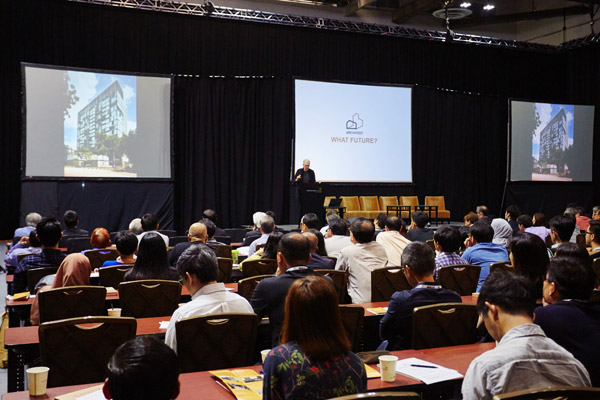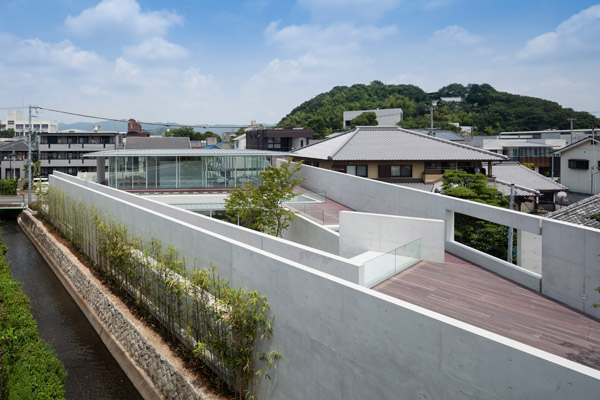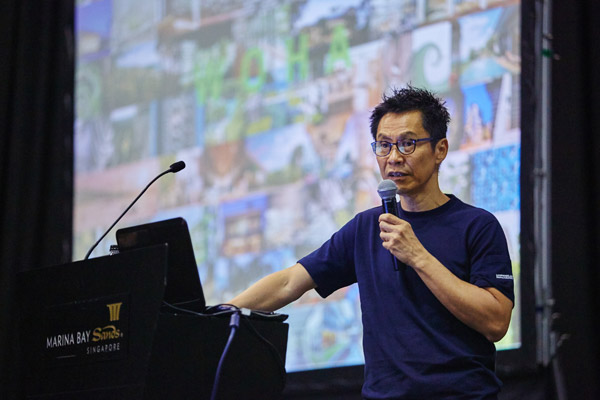Four leading architects from Singapore and the region were invited to this year’s Archifest conference to share their thoughts on the future of our built environment. Justin Zhuang reviews.

October 6th, 2015
Top image: Skyville@Dawson. Photo courtesy of WOHA Architects
To the provocative question of what future lay for architecture, the responses from this year’s Archifest conference were surprisingly measured. Invited speakers Kerry Hill, Professor Waro Kishi, Professor Li Xiaodong – with the exception of Wong Mun Summ – offered moderate answers to the theme of “What Future?” set by the Singapore Institute of Architects (SIA) for its annual festival this year. While acknowledging the profession is now in an “age of uncertainty”, the first speaker of the conference, the 72-year-old architect Kerry Hill, quoted the late English actor Arthur Wing Pinero and declared that “The future is only the past again, entered through another gate.”

The audience at the Archifest conference
Held on 30 September at Sands Expo and Convention Centre, Marina Bay Sands, this year’s Archifest presentations were firmly grounded in reality, as the speakers each spent their allocated 45 minutes showcasing work they have realised, instead of speculating on what lay ahead.

House in Yamanoi by Waro Kishi of K. Associates
Kerry Hill showed how his eponymous studio’s modern approach – focusing on “exactitude” and “authenticity” – achieved timelessness, as seen in how his 15-year-old design for a Kyoto hotel is still valid today, with construction only just gotten underway. Japanese architect Waro Kishi of K. Associates elaborated on his belief that the “future should exist on past experience” with examples of how he inserted his understated buildings into historical Kyoto in order to achieve a “co-existence of history/contemporariness”. And amidst China’s massive urbanisation, Chinese academic Li Xiaodong has eschewed from commercial practice in cities to instead bring architecture into rural areas with designs that are sensitive to nature and the regional context.
Only Wong Mun Summ of WOHA Architects broke away from the trio’s sobering ride into the future, demanding for “21st century solutions to 21st century problems”. The last speaker of this day-long conference urged for architecture to be reassessed to suit a new world of megacities. WOHA’s megastructures, including an upcoming school in Dhaka, public housing in Singapore and apartments in Bangkok, were designed to be sensitive to climate, environmentally sustainable and maximised space in densely-populated cities – just some of the criteria the firm believed is vital for tomorrow’s architecture in the tropical belt.

Wong Mun Summ of WOHA Architects
A common thread amongst all four speakers was the belief in architecture with a capital ‘A’. Their approaches echoed the welcome address by SIA’s new President, Ong Tze Boon of ONG&ONG, when he reminded audiences that, “We are the profession that makes the city.” When the speakers were asked at the concluding Q&A session about the future role of the profession, Wong of WOHA urged architects to wrest back control and play a bigger role in shaping the built environment. The need for professional redefinition is timely in light of technological upheavals such as Singapore’s push to become a smart city, but as conference moderator Tan Szue Hann noted, none of the speakers addressed this issue much.
Like the haze that greeted audiences when they exited the conference held deep inside Archifest’s accompanying trade show ArchExpo, there were no clear answers to the future. Architecture and architects will still be around, but what forms they would take is still very much up in the air.
For more on Archifest and its programmes, visit archifest.sg
A searchable and comprehensive guide for specifying leading products and their suppliers
Keep up to date with the latest and greatest from our industry BFF's!

Sub-Zero and Wolf’s prestigious Kitchen Design Contest (KDC) has celebrated the very best in kitchen innovation and aesthetics for three decades now. Recognising premier kitchen design professionals from around the globe, the KDC facilitates innovation, style and functionality that pushes boundaries.

Savage Design’s approach to understanding the relationship between design concepts and user experience, particularly with metalwork, transcends traditional boundaries, blending timeless craftsmanship with digital innovation to create enduring elegance in objects, furnishings, and door furniture.

Create a configuration to suit your needs with this curved collection.

In the pursuit of an uplifting synergy between the inner world and the surrounding environment, internationally acclaimed Interior Architect and Designer Lorena Gaxiola transform the vibration of the auspicious number ‘8’ into mesmerising artistry alongside the Feltex design team, brought to you by GH Commercial.

To be housed in the 1460 armoury building Sale d’Armi in Arsenale, Venice, this year’s Singapore Pavilion responds to the 18th International Architecture Exhibition’s theme — The Laboratory of The Future — but taking the form of a giant evolving machine that seeks to understand our true desires for how we live in the city.
The internet never sleeps! Here's the stuff you might have missed

Create a configuration to suit your needs with this curved collection.

2024’s theme, “Reawaken,” calls for a journey through reinvention and sustainability.

Overcoming pandemic hurdles to redefine guest experiences amidst Sydney’s bustling entertainment precinct, The Darling has undergone a two-year restoration that melds Art Deco interiors with the necessities of hotel living.